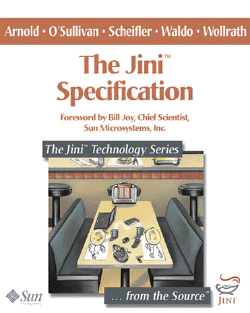The Jini Specification
| Author | Arnold, et al. |
| Publisher | Addison-Wesley |
| ISBN | 0-201-61634-3 |
| Experience level | Intermediate-Expert |
Jini has to be about the hottest new Java technology to be released in years. Imagine a world of plug-and-play networked devices, which can be installed and seamlessly integrated with your LAN simply by connecting them to your network. A laptop on-the-go can just plug in to an unfamiliar network, and access the printer or Internet proxy server, without the need to install any drivers. Mixing Unix and Wintel devices? Not a worry. Jini promises to let them talk to each other.
That's the vision behind Jini. But that vision goes much further. Not only can hardware devices talk to one another, but also software services. In a Jini world, you won't care whether how a device works, or whether it is software or hardware based. An Internet based fax service will act as a fax, as will a hardware device. You'll just look for a fax service, without worrying how the service is implemented.
Of course, someone needs to write the software that will power Jini services. That's where The Jini Specification comes in.
The book is divided into two main sections, an overview and the specification for Jini. The overview provides an easily accessible overview of what Jini is, how it works, and what it can achieve. There are also several examples of Jini services and clients, to give you some practical experience with building Jini software applications.
From there, the book dives headfirst into the actual specification. The first part of the book is good for managers, and software developers alike. The coverage of the specification, however, is designed as a reference for developers as they construct Jini software. This is where many readers could become lost, unless they are already using Jini in action. The first part of the book is a guide to Jini, the second intended only as a reference during development. Finally, a glossary of Jini terms and an essay on distributed computing is included, along with the full source code from the overview.
The Jini Specification is a must-have for anyone considering Jini development. It provides an excellent guide to Jini technology for those considering designing Jini-based systems, and a comprehensive printed reference for those who will implement them. -- David Reilly

Get this title at Amazon.com